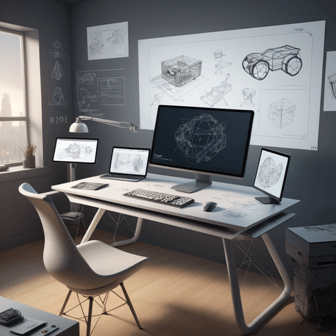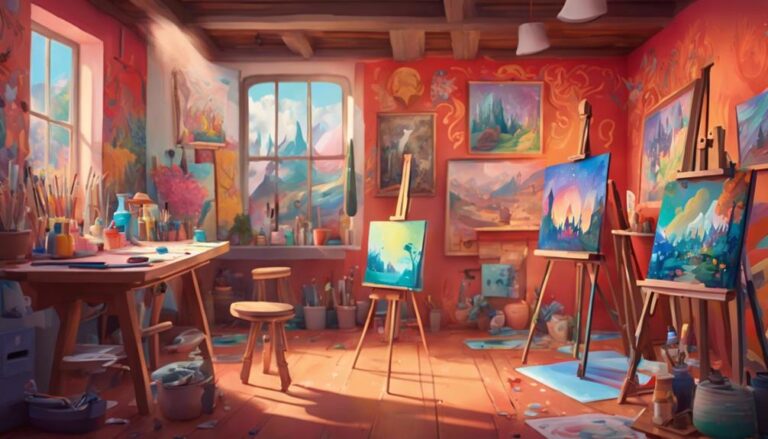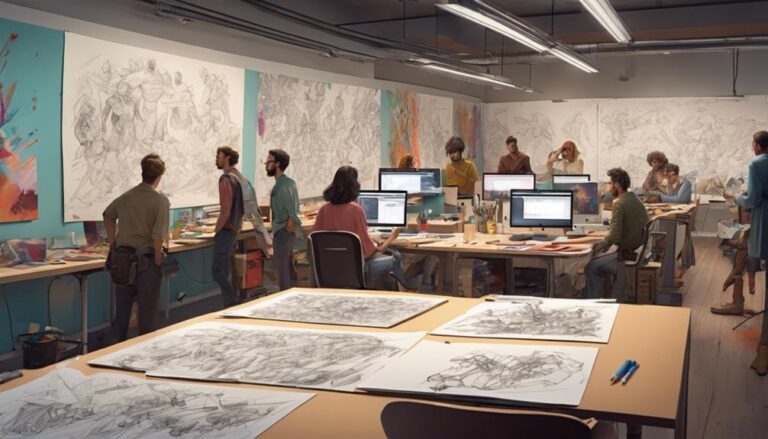Unlocking Animation Potential: Top 3D Modeling Tools
As you venture into the world of 3D animation, you'll quickly realize that having the right tools can make all the difference. You're probably wondering which 3D modeling tools will help you tap into your full animation potential. Industry giants like Blender, Maya, and SketchUp are household names, but what about the newcomers that are shaking things up? You might be surprised to find that some of these lesser-known tools can offer unique features that take your animations to the next level. But which ones are worth exploring, and how can you harness their power to bring your creative vision to life?
Key Takeaways
- Industry standards like STL, OBJ, and FBX facilitate seamless collaboration and interoperability across various 3D modeling applications and platforms.
- Blender, Maya, SketchUp, and 3ds Max are top 3D modeling tools, each offering unique features, compatibility, and pricing options to unlock animation potential.
- Cloud rendering and virtual workspaces enable real-time feedback, global teamwork, and eliminate the need for expensive hardware, streamlining workflows and boosting productivity.
- Emerging trends in 3D modeling introduce game-changing features, redefining the boundaries of 3D modeling, and innovative newcomers are challenging traditional industry standards.
- Advanced 3D modeling tools like Houdini offer procedural 3D modeling approaches, empowering artists to create complex models, and master scene management techniques for efficient organization and optimization.
Industry Standards for 3D Modeling
When working with 3D models, you'll encounter a range of industry standards that govern the creation, exchange, and use of 3D data, facilitating seamless collaboration and interoperability across various applications and platforms.
These standards have undergone significant evolution over the years, driven by the need for improved efficiency, accuracy, and compatibility.
As the industry has grown, so too have the standards, with bodies like the International Organization for Standardization (ISO) and the American Society of Mechanical Engineers (ASME) playing key roles in their development.
In the 3D modeling space, software comparisons often revolve around their compliance with industry standards.
For instance, formats like STL, OBJ, and FBX have become ubiquitous, allowing for easy data exchange between different tools and platforms.
Similarly, standards like Collada and glTF have emerged as popular choices for real-time 3D applications.
By adhering to these standards, 3D modeling software can guarantee that their outputs are compatible with a wide range of downstream applications, from game engines to computer-aided design (CAD) systems.
As you navigate the world of 3D modeling, understanding these industry standards will be vital to achieving seamless collaboration and maximizing the potential of your 3D data.
Blender: Free and Powerful Option
With its extensive feature set, cross-platform compatibility, and zero-dollar price tag, Blender has established itself as a formidable competitor in the 3D modeling software landscape, offering a powerful alternative to commercial options. As a 3D modeler, you'll appreciate Blender's robust toolset, which includes advanced modeling, sculpting, and rendering capabilities. Plus, its open-source nature and large community of users and developers guarantee that Blender is constantly evolving and improving.
| Feature | Description |
|---|---|
| Modeling Tools | Advanced polygon modeling, sculpting, and curve editing |
| Rendering | Cycles rendering engine with GPU acceleration |
| Animation | Keyframe animation, physics simulations, and rigging |
To get started with Blender, you can tap into the wealth of online resources, including Blender tutorials online and extensive documentation. The Blender community support is also exceptional, with active forums, social media groups, and local meetups. With Blender, you can create stunning 3D models and animations without breaking the bank.
Maya: Professional-Grade 3D Modeling
As a 3D modeler, you're likely to find Autodesk Maya's professional-grade features and industry-standard tools well-suited for creating complex, high-performance 3D models and animations. With Maya, you'll have access to a robust set of tools and features that can help you bring your most ambitious projects to life. Whether you're working on film, TV, video games, or architectural visualization, Maya's got you covered.
Some of the key benefits of using Maya include:
Advanced modeling and sculpting tools: Maya's modeling and sculpting tools allow for precise control and manipulation of 3D objects, making it ideal for creating complex, high-detail models.
Powerful animation and simulation capabilities: Maya's animation and simulation tools enable you to create realistic character animations, dynamic simulations, and stunning visual effects.
Extensive library of Maya tutorials and resources: Autodesk provides a vast array of tutorials, online courses, and documentation to help you get started with Maya and improve your skills.
Customizable with Maya plugins: Maya's plugin architecture allows you to extend its functionality with third-party scripts and tools, further streamlining your workflow.
With Maya, you'll be able to take your 3D modeling skills to the next level and produce stunning, professional-grade results.
Innovative Newcomers in 3D Modeling
As you explore the 3D modeling landscape, you'll notice that modern alternatives are emerging to challenge traditional industry standards.
These innovative newcomers are introducing game-changing features that are redefining the boundaries of 3D modeling.
Modern Alternatives Emerge
You're now spoiled for choice with innovative newcomers in 3D modeling, offering novel viewpoints and sleek interfaces that challenge traditional industry giants.
These modern alternatives bring a blast of innovation to the industry, leveraging cutting-edge technologies to streamline workflows and boost productivity.
Some notable features of these newcomers include:
Cloud Rendering: Scalable rendering capabilities that eliminate the need for expensive hardware, allowing artists to focus on creativity rather than technicalities.
Virtual Workspaces: Collaborative environments that enable real-time feedback and seamless communication, breaking geographical barriers and fostering global teamwork.
Real-time Feedback: Instant visualization of changes, enabling artists to experiment and iterate rapidly, and make data-driven decisions.
Modular Architecture: Flexible, component-based designs that facilitate customization and extension, catering to diverse project requirements and artistic visions.
These innovative newcomers are redefining the 3D modeling landscape, providing artists and studios with unprecedented creative freedom and technical capabilities.
Game-Changing Features Unveiled
Frequently, these innovative newcomers in 3D modeling are introducing game-changing features that revolutionize the industry, and one such feature is AI-assisted modeling, which empowers artists to generate complex shapes and patterns with unprecedented speed and accuracy.
You'll notice that AI-driven tools can now create intricate designs, from organic forms to mechanical components, in a fraction of the time it took previously.
This means you can focus more on creative direction and less on tedious modeling tasks.
Another game-changing innovation is real-time rendering, which allows you to see the results of your work instantaneously.
This revolutionary update enables you to experiment with different materials, lighting setups, and camera angles without waiting for hours or even days for the rendering process to complete.
With real-time rendering, you can iterate faster, make changes on the fly, and deliver high-quality results in record time.
SketchUp: 3D Modeling Simplified
Simplifying 3D modeling, SketchUp streamlines the design process by providing an intuitive interface and a robust set of tools that let you focus on bringing your ideas to life.
As you plunge into SketchUp Basics, you'll appreciate the user-friendly interface that makes it easy to navigate and learn. The software is designed to help you think creatively, rather than getting bogged down in technical complexities.
Easy to learn: SketchUp's intuitive interface means you can start creating 3D models quickly, even if you're new to 3D modeling.
Fast workflow: With SketchUp, you can work efficiently and make changes on the fly, without having to worry about complex software.
Accurate models: SketchUp's robust set of tools guarantees that your 3D models are accurate and precise, every time.
Seamless collaboration: Share your designs easily with others, and collaborate in real-time using SketchUp's cloud-based platform.
3ds Max: Advanced 3D Modeling
ds Max is particularly well-suited for modeling complex architectural designs, allowing you to create highly detailed and realistic buildings.
Its advanced scene management capabilities also make it an ideal choice for large-scale projects.
As you work with ds Max, you'll appreciate its ability to handle intricate models and scenes with ease.
Model Architecture Design
With Autodesk's 3ds Max, you can create intricate architecture designs by leveraging its advanced modeling tools to craft complex shapes, structures, and details.
This software allows you to tackle projects with high structural complexity, making it an ideal choice for architects, engineers, and designers.
When working on building information models, 3ds Max provides a robust platform to create accurate and detailed designs.
To take your architecture designs to the next level, consider the following key aspects:
Parametric modeling: Create complex shapes and structures using 3ds Max's parametric modeling tools, allowing for precise control over design elements.
Material manipulation: Assign realistic materials to your designs, taking into account factors like texture, reflectivity, and transparency.
Lighting and rendering: Utilize 3ds Max's advanced lighting and rendering tools to create stunning visualizations of your architecture designs.
Data integration: Seamlessly integrate your designs with other Autodesk tools, such as Revit, to streamline your workflow and guarantee data consistency.
Advanced Scene Management
As you dive deeper into complex 3D modeling projects, mastering advanced scene management techniques in 3ds Max becomes essential to efficiently organize and optimize your scenes, ensuring smooth navigation and rendering.
A well-structured Scene Hierarchy is pivotal in achieving this. You'll want to create a logical object organization system, grouping related objects into layers and folders. This allows you to quickly locate and select specific objects, making it easier to manage complex scenes.
In 3ds Max, you can utilize the Scene Explorer to visualize and manipulate your Scene Hierarchy. This tool enables you to create, rename, and reorder objects, as well as set object properties and animation controllers.
You can also use the Layer Manager to organize objects into logical groups, controlling their visibility, renderability, and more.
Houdini: Procedural 3D Modeling
Houdini's procedural 3D modeling approach empowers artists to create complex models by defining a sequence of operations that can be repeated, varied, and combined to generate unique geometries.
This approach allows you to work efficiently and make changes quickly, as modifications to the process automatically propagate to the entire model.
As a 3D artist, you'll appreciate Houdini's node-based system, which enables you to create complex procedural workflows by connecting nodes that represent individual operations.
This visual representation of your workflow makes it easy to understand and modify.
Flexibility: Easily create variations of your model by modifying the sequence of operations.
Efficiency: Make changes quickly, as the procedural approach updates the entire model automatically.
Scalability: Create complex models with ease, as the procedural workflow handles the complexity for you.
Reusability: Use and reuse existing workflows to speed up your modeling process.
ZBrush: Digital Sculpting Tool
When you use ZBrush, you'll find that sculpting becomes a highly intuitive process, allowing you to create complex, high-resolution models with ease.
The software's unique features enable you to generate organic shapes that mimic real-world textures and structures.
As you work with ZBrush, you'll appreciate how it streamlines your workflow, letting you focus on bringing your creative vision to life.
Sculpting Made Easy
With ZBrush, you can plunge into the world of digital sculpting, effortlessly manipulating virtual clay to create highly detailed, organic models.
As a digital sculptor, you'll appreciate how ZBrush streamlines sculpting fundamentals, allowing you to focus on bringing your creative vision to life. The intuitive interface and powerful tools make it easy to master the basics of digital sculpting, from roughing out shapes to refining intricate details.
Dynamic brush engine: ZBrush's brush engine allows for realistic sculpting, with tools that mimic traditional media like clay, wax, and stone.
Real-time feedback: See your changes as you make them, with no lag or waiting for renders.
Non-linear workflow: Work on your model from any angle, at any time, without worrying about layers or hierarchies.
Unlimited undo: Experiment freely, knowing you can always backtrack if needed.
High-Resolution Models
Creating high-resolution models in ZBrush allows you to capture every nuance and detail of your digital sculpture, resulting in models that are incredibly lifelike and photorealistic.
With ZBrush, you can achieve high-res textures that showcase even the smallest details, making your models stand out.
The software's ability to handle detailed geometries means you can create complex shapes and structures with ease, giving you unparalleled control over your digital creations.
When working with high-resolution models, you'll appreciate ZBrush's advanced sculpting tools, which allow you to refine and perfect your design.
The software's dynamic brush system enables you to adjust brush sizes and shapes on the fly, ensuring precise control over your strokes.
Additionally, ZBrush's powerful remeshing tools enable you to optimize your model's geometry, reducing polygon counts and improving overall performance.
Organic Shape Creation
You can generate organic shapes in ZBrush by manipulating virtual clay, allowing for the creation of complex, free-form structures that mimic those found in nature.
This digital sculpting tool provides a unique approach to 3D modeling, enabling you to create intricate, curved surfaces with ease.
When working with ZBrush, you'll employ freeform modeling techniques to shape and deform your model.
This process involves pushing, pulling, and manipulating the virtual clay to achieve the desired form.
ZBrush's powerful algorithms guarantee that your model's topology is maintained, even as you make drastic changes to its shape.
Some key benefits of using ZBrush for organic shape creation include:
- Unparalleled flexibility: Make drastic changes to your model's shape without worrying about topology issues.
- Highly detailed models: Achieve intricate, high-resolution details that would be impossible to achieve with traditional modeling techniques.
- Realistic results: Create models that mimic the complexity and beauty of natural forms.
- Streamlined workflow: Focus on creative experimentation, rather than worrying about technical limitations.
Modo: 3D Modeling and Rendering
Modo's versatile 3D modeling and rendering capabilities empower artists to bring their creative visions to life with precision and accuracy.
As you plunge into Modo, you'll appreciate its intuitive interface and customizable workflow. You can create complex models using a variety of tools, including subdivision surface modeling, polygon modeling, and sculpting.
Modo's workflow is highly customizable, allowing you to create tailored 3D workflows that fit your specific needs. You can also take advantage of modo shortcuts to streamline your workflow and increase productivity.
With Modo, you can render stunning images and animations using its advanced rendering engine, which supports physically-based rendering, global illumination, and more. Whether you're working on a still image or an animated sequence, Modo's rendering capabilities will help you achieve photorealistic results.
Cinema 4D: Motion Graphics Powerhouse
With its robust feature set and intuitive interface, Cinema 4D has established itself as a leading motion graphics powerhouse, allowing artists to craft complex, high-end animations and 3D models with ease.
As you delve into the world of motion design, you'll find that Cinema 4D provides a solid foundation for mastering motion design principles.
With its vast library of tutorials and resources, you can quickly get up to speed with the software's capabilities.
Cinema 4D's node-based workflow allows for a high degree of control and flexibility when creating complex animations and 3D models.
The software's advanced simulation tools enable you to create realistic simulations, from hair and cloth to rigid body dynamics.
Cinema 4D's integrated rendering engine provides high-quality renders with minimal setup and configuration.
Cinema 4D's seamless integration with Adobe After Effects makes it easy to incorporate 3D elements into your motion graphics projects.
Frequently Asked Questions
Can I Use 3D Modeling Tools for Architectural Visualization?
You can leverage 3D modeling tools for architectural visualization, ensuring architectural accuracy and realistic rendering by creating detailed building models, applying textures, and using lighting effects to produce stunning, photorealistic visuals.
Do I Need Programming Skills for 3D Modeling?
You don't necessarily need programming skills for 3D modeling, as most software offers user-friendly interfaces, allowing you to focus on your artistic vision and creative freedom, without getting bogged down in coding.
Are Free 3D Modeling Tools Suitable for Commercial Use?
You'll find that free 3D modeling tools can be suitable for commercial use, but be aware of business restrictions and cost limitations that may impact your project's scalability, flexibility, and overall success.
Can I Import 2D Designs Into 3D Modeling Software?
You can import 2D designs into 3D modeling software, but be aware of file format compatibility and design limitations, as some tools may not support complex conversions or retain original design intent.
Are 3D Modeling Tools Compatible With Virtual Reality Platforms?
You'll find that most 3D modeling tools offer VR headset integration, ensuring seamless interaction with virtual reality platforms, and cross-platform compatibility, allowing you to easily export and import models between different devices and systems.
Conclusion
You've now explored the top 3D modeling tools to tap your animation potential.
From industry standards like Blender and Maya to specialized tools like Houdini and ZBrush, each offers unique strengths to enhance your creative workflow.
By mastering these tools, you'll streamline your process, boost productivity, and produce stunning visuals that captivate audiences worldwide.
Take your animation skills to the next level and bring your most imaginative concepts to life.






